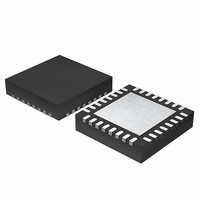EFM32G200F64 Energy Micro, EFM32G200F64 Datasheet - Page 68

EFM32G200F64
Manufacturer Part Number
EFM32G200F64
Description
MCU 32BIT 64KB FLASH 32-QFN
Manufacturer
Energy Micro
Series
Geckor
Datasheets
1.EFM32G200F16.pdf
(63 pages)
2.EFM32G200F16.pdf
(10 pages)
3.EFM32G200F16.pdf
(463 pages)
4.EFM32G200F16.pdf
(136 pages)
Specifications of EFM32G200F64
Core Processor
ARM® Cortex-M3™
Core Size
32-Bit
Speed
32MHz
Connectivity
EBI/EMI, I²C, IrDA, SmartCard, SPI, UART/USART
Peripherals
Brown-out Detect/Reset, DMA, POR, PWM, WDT
Number Of I /o
24
Program Memory Size
64KB (64K x 8)
Program Memory Type
FLASH
Ram Size
16K x 8
Voltage - Supply (vcc/vdd)
1.8 V ~ 3.8 V
Data Converters
A/D 4x12b, D/A 1x12b
Oscillator Type
External
Operating Temperature
-40°C ~ 85°C
Package / Case
32-VQFN Exposed Pad
Processor Series
EFM32G200
Core
ARM Cortex-M3
Data Bus Width
32 bit
Data Ram Size
16 KB
Interface Type
I2C, UART
Maximum Clock Frequency
32 MHz
Number Of Programmable I/os
24
Number Of Timers
2
Operating Supply Voltage
1.8 V to 3.8 V
Maximum Operating Temperature
+ 85 C
Mounting Style
SMD/SMT
Minimum Operating Temperature
- 40 C
Lead Free Status / RoHS Status
Lead free / RoHS Compliant
Eeprom Size
-
Lead Free Status / Rohs Status
Details
Available stocks
Company
Part Number
Manufacturer
Quantity
Price
3.6.1.5 Examples
3.6.2 UMULL, UMLAL, SMULL, and SMLAL
3.6.2.1 Syntax
3.6.2.2 Operation
3.6.2.3 Restrictions
3.6.2.4 Condition flags
2011-02-04 - d0002_Rev1.00
Signed and Unsigned Long Multiply, with optional Accumulate, using 32#bit operands and producing
a 64#bit result.
op{cond} RdLo, RdHi, Rn, Rm
where:
op
cond
RdHi, RdLo
Rn, Rm
The UMULL instruction interprets the values from Rn and Rm as unsigned integers. It multiplies these
integers and places the least significant 32 bits of the result in RdLo, and the most significant 32 bits
of the result in RdHi.
The UMLAL instruction interprets the values from Rn and Rm as unsigned integers. It multiplies these
integers, adds the 64#bit result to the 64#bit unsigned integer contained in RdHi and RdLo, and writes
the result back to RdHi and RdLo.
The SMULL instruction interprets the values from Rn and Rm as two’s complement signed integers. It
multiplies these integers and places the least significant 32 bits of the result in RdLo, and the most
significant 32 bits of the result in RdHi.
The SMLAL instruction interprets the values from Rn and Rm as two’s complement signed integers. It
multiplies these integers, adds the 64#bit result to the 64#bit signed integer contained in RdHi and RdLo,
and writes the result back to RdHi and RdLo.
In these instructions:
• do not use SP and do not use PC
• RdHi and RdLo must be different registers.
These instructions do not affect the condition code flags.
MUL
MLA
MULS
MULLT
MLS
R10, R2, R5
R10, R2, R1, R5 ; Multiply with accumulate, R10 = (R2 x R1) + R5
R0, R2, R2
R2, R3, R2
R4, R5, R6, R7
; Multiply, R10 = R2 x R5
; Multiply with flag update, R0 = R2 x R2
; Conditionally multiply, R2 = R3 x R2
; Multiply with subtract, R4 = R7 - (R5 x R6)
is one of:
UMULL Unsigned Long Multiply.
UMLAL Unsigned Long Multiply, with Accumulate.
SMULL Signed Long Multiply.
SMLAL Signed Long Multiply, with Accumulate.
is an optional condition code, see Section 3.3.7 (p. 43) .
are the destination registers. For UMLAL and SMLAL they also hold
the accumulating value.
are registers holding the operands.
...the world's most energy friendly microcontrollers
68
www.energymicro.com


















